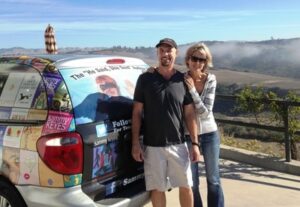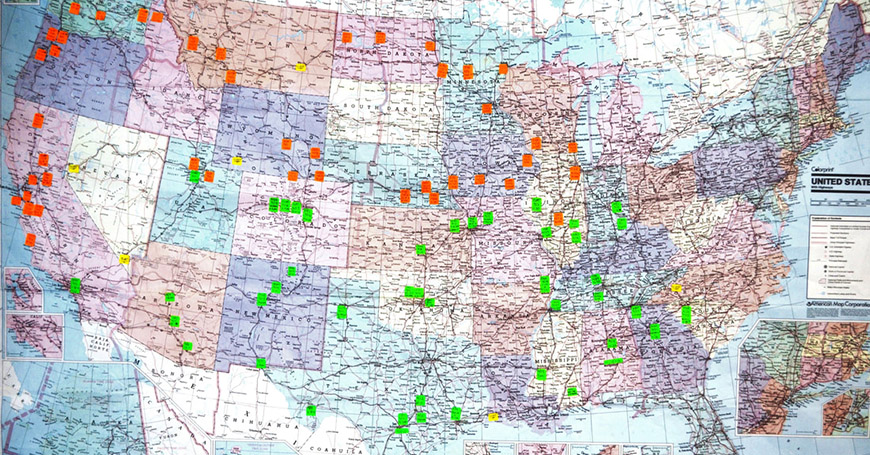 by Mark Parsons
by Mark Parsons
We’ve gone on three different book tours within the past year. First for my wife’s newest book, The Peach Rebellion, last May, then for my latest, The 9:09 Project, in November/December. Since both books were published within six months of each other—different imprints of the same umbrella house—we couldn’t pass up the opportunity to go on a He Said/She Said—Part II* joint book tour. We returned a week ago as I write this.
To recap, the original He Said/She Said tour was a four-month national book tour covering more than 100 venues. Probably the biggest U.S. book tour of that year.
The original post covered the why of touring from a philosophical viewpoint, but I’ve gotten questions about the logistics, aka the who, what, when, where, and how of setting up and executing a book tour. When I was younger I spent a fair amount of time on the road in different bands, and many of those logistical lessons certainly came in handy when booking that big, crazy tour half a dozen years ago. So let’s dive in…
When
The first decision—before you even figure out where you’re going and which stores to visit—is when to tour. The best time is when you have a new book out. Throughout the life of most books the briskest selling period will be in the first few months, and you, as well as the event coordinators at the stores, will want to capitalize on that. If there’s no new release but you have a backlist that sells well, this can work. You could tour with a friend who writes in the same genre who has a book coming out. Think about how big musical acts tour—they either have a new record out, do a greatest hits tour, or package a tour with like-minded bands that have a similar fan base.
Decide how long you want to be out. You might average one store an evening with one non-store presentation (school, conference, festival) during the day. Weekends are different. You can visit stores during the day and evening. If you want to present at a minimum of a dozen stores, plan on a couple of weeks. Once you know how long you can go on tour and the rough number of stores you’d like to visit, you can plan your route.
Where
A workable plan looks like this: Pick an efficient route that goes through a number of target-rich environments—in other words, a major interstate that passes through a number of cities and towns that have bookstores. A loop route is better than an out-and-back, because you don’t want to hit stores too close to other stores you’re seeing. The stores don’t like it, and you’re drawing from the same well of customers twice, so a circular route gives you twice as much fresh territory. Our overall rule was stores should be at least twenty miles apart and ideally farther. Big cities are an exception, because two stores ten miles apart can have different customer bases. This comes up in conversations with the event coordinators.
A few factors help determine the route specifics—where you live, special places you have as a goal destination, and desired daily mileage. You can bang out 500 miles or more in a day when you have to get across a book desert to get to another locale, but it’ll wear you out and take away all the fun. We try not to schedule more than 200 miles for normal tour days. That’s three or four hours of luxurious sightseeing per day broken up by meal stops, which makes for an easy cruise. The goal isn’t to cover the most miles, it’s to visit the most stores, so venues closer together makes for a more efficient tour.
Who
Once you know the route, it’s time to look for venues. Good sources of info: The American Booksellers Association website. Click their Find a Bookstore tab, then enter the city to search, enter bookstore into the Nearby tab on Google Maps when you map a location. Also word-of-mouth from fellow authors, indie bookstores, or ask for recommendations on social media.
You’ll have your own personal criteria. We looked for indie bookstores that had good connections to the local community, with bonus points for book clubs and/or writers groups, a coffee bar, and a store dog or cat. Number of books in stock might be a consideration for you. A store with 5,000 books is less likely to carry your titles than one with 50,000 books. Some of our best and most successful visits were at smaller stores.
Look for more prospects than you’ll need. Take the total number of days you’ll to be out and multiply by two or three, ideally two or more in each target city on the route.
What
This may be the easiest part: decide on your presentation. Consider these three categories of signings: the Sit and Sign, the Read and Sign, and the Present and Q&A. The critical task is to come up with a general idea of what works for you, your books, your audience, and the bookstore. You have to sell it to the event coordinators at your target venues. If they don’t think you have something of interest to their customers, it’s going to be a harder sell. My overall advice here is: the worst way to get people interested in your work is to drone on about it. If you come off as interesting or informative, they’ll be inclined to think your book is likewise, and will check it out. Do not shout “Buy my book!” at potential readers. It’s bad form…and it never works.
You don’t need every detail, just enough to say, “I have a presentation that covers X, Y, and Z, and I take questions. I sign for everyone who buys, and I’ll sign whatever stock you have.”
How
Let’s step through the nuts and bolts of the preliminary actions. You’ll want to start this process several months in advance.

- Buy a big-ass map of your potential tour area and put it on the wall. Get small colored stickers.
A. We used different stickers for initial, provisional, and confirmed.
B. Don’t highlight your route, because it will change.
2. Build documents to track the information discussed below. We ended up with an overall plan and a page for each day of the tour with venue, location, time/date, name of contact. My wife builds informative spreadsheets.
3. For each city, look at the list of candidates and order them in terms of your preference.
4. Contact your first choice for each given date/location. Phone is the best for this. Introduce yourself, explain the tour dates, and obtain/verify Event Coordinator name and contact info which is the whole purpose of this call.
A. Place an initial contact sticker on the location.
B. Go to the next and do the same.
5. Contact the event coordinator, usually in a follow-up call or email. Explain the tour basics and the rough time frame you’ll be in their area and get provisional approval. Explain you’ll confirm a specific time/date when the schedule is finalized.
A. If they pass, go on to your second choice.
6. Do this for every venue on your route.
A. You don’t want two stores in the same market, but you don’t want big gaps of several hundred miles.
7. Go to your first choice and confirm a start date/time. This is your anchor, and everything will stem from this date. Replace the provisional sticker with a confirmed one.
A. Send a confirmation document to the event coordinator with all pertinent information.
8. Go to the next store on your route approved a visit and book them for the next day.
9. Continue through the rest of your route. You’ll still get initial approvals for the end of the tour while you finalize the early stops. At that point you say, “We’re scheduled to come through your area during the middle of the first week of August, so can we pencil in the 3rd or 4th and confirm the details in a couple of weeks?”
In Part II, we’ll cover the details around scheduling the signings, school visits, and the logistics of booking rooms.
Happy tour planning!
Mark Parsons is a frequent presenter at conferences, festivals, and schools, speaking on the craft and business of writing. He is a critically acclaimed YA author—his newest novel is The 9:09 Project, out now from Delacorte/Random House. He has written extensively in the nonfiction arena, authoring over two-hundred articles for national publications as well as a pair of nonfiction books.

Pingback: Writers and Publishers Network